Are Jon Boats Stable?
If you ask whether Jon Boats are stable, some people would say that they are, and others would warn you to stay away from them because they are tippy and unreliable. Their answer would depend on what they understand by ‘Stability’, what kind of Jon boat they see in their mind, and in what kind of water they see it being used in (flat water or choppy water), and these are often based on personal experience.
Is there a stability difference between a Jon boat and a skiff?
Both skiffs and Jon boats are flat bottom lightweight boats that differ in certain hull details, materials used in their construction, and deck structures.
Both are designed to offer as much stability as possible for a small mono-hull boat going on flat water, and as such, they are stabler than wide canoes and kayaks of the same length.
Foot for foot and inch for inch, there are no major differences between Jon boats and skiffs in terms of the stability they offer, except for the fact that the passengers of a Jon boat typically sit and stand lower than the passengers and users of a skiff, so they feel more stable. In other words, a Jon boat and a skiff of the same size, namely length and width, offer a similar degree of stability, with the Jon boat being typically more stable on flat water, while skiffs that feature a V hull are more stable in moving water.
The S4 is stabler than both Jon boats and skiffs –
The twin-hull (“catamaran”) Wavewalk S4 Microskiff is the world’s most stable portable boat. In fact, it is more stable than many Jon boats and skiffs that feature a much bigger hull, as shown in these photos of three fishermen fishing standing in it –
Click images to enlarge
Thanks to its patented twin-hull and longitudinal saddle seat, the S4 offers its users to stand and sit with each foot resting firmly on the bottom of its respective hull, below waterline. Each hull is sufficiently buoyant to support the user’s entire weight, if needed, so they can balance themselves intuitively, easily, and effectively. The S4 a seaworthy microskiff.
Who Uses Jon Boats, and Where?
Jon boats are small fishing boats that are popular among inland fishermen who fish ponds, small lakes, marshes, and slow moving rivers, namely flat water that’s usually well protected from wind, waves, and preferably from fast motorboats that generate big wakes. These anglers may fish alone, but typically they fish in crews of two. Bigger Jon boats can be used in bigger lakes and rivers.
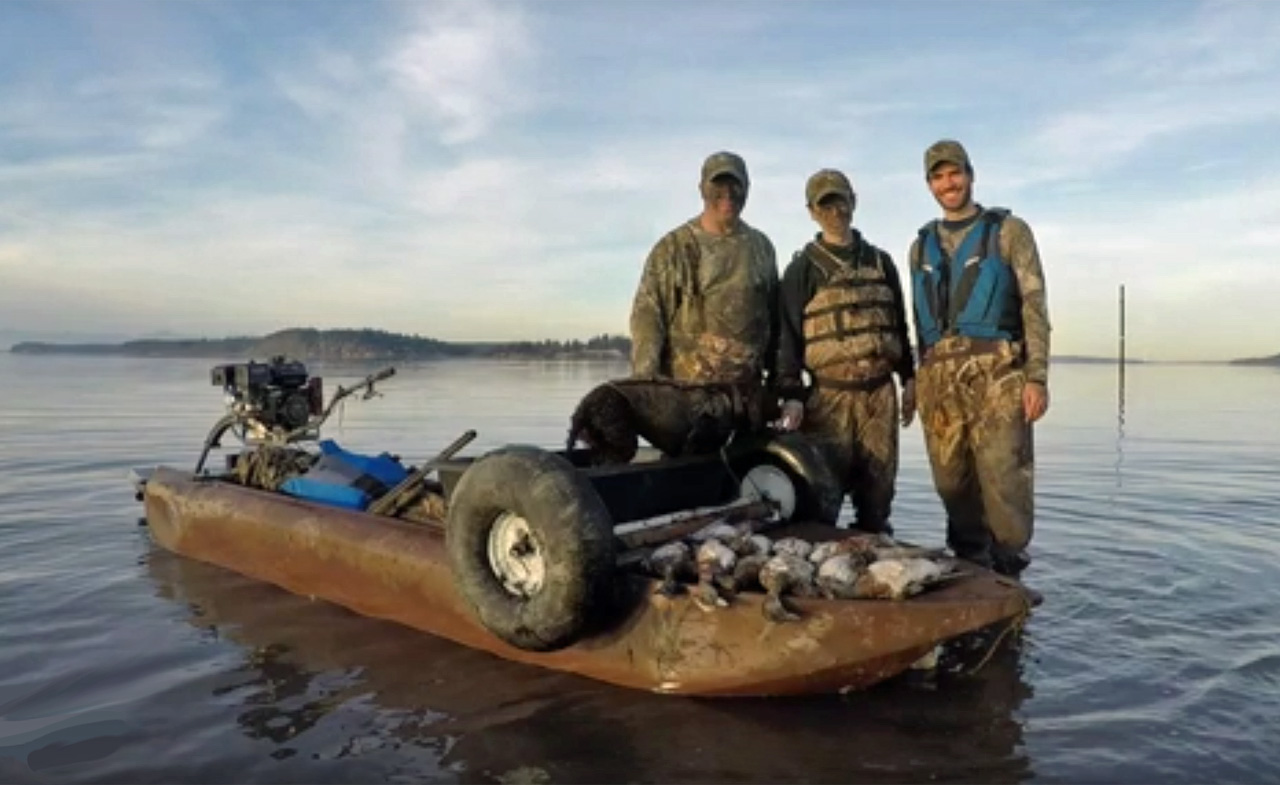
Factors in Jon Boats’ Stability
Structure, size and passengers
A typical Jon boat features a flat bottom designed to make it draft as little as possible, and thus work well in shallow water, while other Jon boats feature a bottom that’s partially V shaped (sometimes referred to as “Semi-V”) that drafts a little more but offers better performance in choppy water. This V shape should not be confounded with the more seaworthy Deep-V design.
Jon boats can vary in width (Beam) from less than 3 ft to over twice as much, and this difference results in big variations in their stability, in this case initial (primary) stability, sometimes dubbed reserve stability.
When watercraft as small as Jon boats are concerned, passengers are typically the heaviest things on board, which is why passengers’ location and movements can greatly affect the boat’s stability.
Narrow-beam Jon boats are notoriously unstable, especially with a crew of two on board. Their instability can be felt even when they are used for fishing ponds and small lakes, where they are expected to perform at their best. Reading articles about Jon boat stability and user testimonials on this subject could lead the reader to the conclusion that any Jon boat that’s narrower than 48″ might not be stable enough for a tandem crew, and starting from this size, Jon boats get sufficiently stable, especially longer models. Another factor that affects a Jon boat’s stability is its length, since it acts as an enhancement to its width – A longer Jon boat is more stable than a shorter Jon boat of identical width (Beam).
External factors
External factors may destabilize a Jon boat as well, or at least destabilize the passengers on board – Such factors can be wind, waves and other boats’ wakes that hit the boat, especially on its sides (lateral waves).
Size matters, but it may not be enough
We found the following instructions for Calculating a Boat’s Capacity to Carry a Number of Passengers on a boating education website:
On boats less than 20 feet long, the following rule of thumb can be used to calculate the number of persons (weighing 150 lbs each) the boat can carry safely in fair weather and calm water conditions:
Number of passengers = boat length in ft x boat width in ft : 15
Example for a good size Jon boat or skiff: 15 ft x 4 ft = 60, and 60:15 = 4 passengers
However, the above formula seems outdated in view of the fact that these days the average adult US female weighs 160 lbs, and the average adult US male weighs 200 lbs.
Therefore, to calculate the number of adult passengers in a Jon boat, we suggest to use the same formula and divide the result by 20 instead of by 15.
Example for the same Jon boat or skiff: 15 ft x 4 ft = 60, and 60:20 = 3 passengers
Can the 13 ft long and 38″ wide Wavewalk S4 carry 3 passengers on board?
The answer is yes, in fair weather and calm water conditions, and seen in this short video featuring the S4 driven in choppy water, carrying 3 guys on board:
Balancing capability
When small craft are concerned, the boat’s own stability plays an important role in the overall stability of the combined boat and crew, but the passengers’ ability to balance themselves effectively is critical as well, which is to say that a wider Jon boat may not necessarily offer better means for its crew to balance themselves effectively –
Jon boats often feature rudimentary bench-like seats that are similar to ones found in canoes and dinghies, or high swivel seats such as can be found in bass boats. Neither types of seats are optimized for supporting the user’s balancing efforts, and they’re not very good in keeping their user anchored to their place and in full control of their body’s center of gravity (CG).
This ergonomic deficiency exposes a Jon boat’s passenger to unexpected lateral (side) motion, as well as vertical motion, whether such motion is the result of an external force such as a wave or another boat’s wake, the movement of another passenger on board, or even the strong reaction of the boat to that passenger’s own movements. More specifically, people on board a Jon boat can have a hard time finding their footing and balancing themselves intuitively, comfortably and effortlessly, and from the moment they lose their footing and balance, their own weight can act as an additional destabilizing factor that may tip the boat over, send its passengers overboard, and in some cases even overturn the boat.
A Jon boat of a smaller size works better as a fishing boat for one angler than it does for a crew of two.
Directional stability and lateral stability
Typically, Jon boats are motorized, and the flat bottomed ones can be easily deflected from their course as well as destabilized when going in lateral waves, especially at higher speeds. In such cases, the deficiency in a Jon boat’s lateral stability can become more problematic by the lack of good directional stability (tracking capability) that characterizes such boats, in particular ones that feature a flat bottom. People who use such boats are quick to head back home as soon as the wind picks up.
Jon boats with a V-shaped hull do better in waves and wind, thanks to the fact that they have some capability to go through waves and not necessarily on top of them, which isn’t the case with flat bottomed Jon boats that are essentially designed for use on flat water only.
This said, although Jon boats are not considered to be seaworthy craft, the bigger ones are sufficiently stable to offer a good experience to a crew of two or more anglers who fish inland, preferably in calm and protected waters, and away from fast motorboat traffic.
Stability: Jon Boats vs. S4
A detailed stability comparison between Jon boats and the Wavewalk S4microskiff is almost impossible to complete, because Jon boats vary so much in size and structure, and they can range from a flat bottomed, 32″ wide and 10 ft long (1032) boat to a V-bottom 72″ wide and 18 ft long one (1872), which can be assigned to another class of boats.
The Wavewalk form presents two main stability advantages:
The first comes from the fact that all the Wavewalk’s buoyancy is distributed as far as possible from the boat’s center line, where this buoyancy works more effectively to support lateral changes, whether such changes are external of generated on board.
The second advantage is the Wavewalk’s Personal Watercraft saddle seat that offers the passengers who ride it optimal, easy and intuitive means to balance themselves. This advantage is critical in view of the fact that the passengers’ total weight can be as big the the Jon boat’s weight, and it often exceeds this weight. For example, in the photo above, the passengers’ aggregated weight exceeds the S4’s weight by a factor of 5:1.
So, in order to avoid tedious detailed stability comparisons, let us simplify things and state that in general, the bigger models in the Jon boat class (over 54″ beam) are more stable than the S4, the smaller Jon boat models (less than 48″ beam) are less stable, and as for the the midsize models (48″ to 54″) the answer would depend on parameters such as their length (longer is more stable), and whether they feature a flat bottom or a V-shaped bottom, as discussed in the previous section of this article.
Bottom line: Compared to the traditional Jon boat design, the Wavewalk S4’s form and improved ergonomics add stability which is the equivalent of about 1 ft in width.
Portability and paddling capacity
More specifically, the S4 is stabler than any car-topper namely portable Jon boat. Which is to say that if you’re looking for a Jon boat that’s more stable than the S4, you must take into consideration transporting and storing it on a large size trailer, as well as limitations in launching it, namely being dependent on launch ramps that come with trailer boats. Such a big Jon boat would not be more seaworthy than an S4.
In addition, the S4 is more stable than any Jon boat that can be propelled by means of paddling, whether it’s with dual blade (kayak) paddles or single-blade (canoe) paddles. This fact is particularly meaningful when very shallow water (‘skinny water’) fisheries are concerned, and no-motor zones (NMZ).
Seaworthiness
Generally speaking, Jon boats are not considered as being seaworthy, while Wavewalk’s boats are more seaworthy thanks to their good tracking capability, advanced ergonomics, and secondary stability. These factors allow for high performance when dealing with choppy water, which is why the S4 punches far above its weight in terms of Seaworthiness.
Payload
Small craft are penalized for their size in several ways, and one of them is their sensitivity to carrying more weight on board, which makes them slower and less stable. This is true for all boat designs, including Jon boat and Wavewalk. Therefore if you’re looking for stability for a larger crew of heavier people, say two big and heavy guys or more, your best bet is a very large Jon boat or skiff, that is 6 ft or more in width, and over 16 ft in length, and preferably with a V shaped bottom, so that you could drive it at higher speed. Two large size fishermen can go in an S4 and have a great time traveling and fishing for an entire day without experiencing any stability problem, even standing up, but they would not necessarily be able to go at speeds as high as a large size Jon boat or skiff offers.
The Wavewalk S4 in Gator Green, a typical Jon boat color
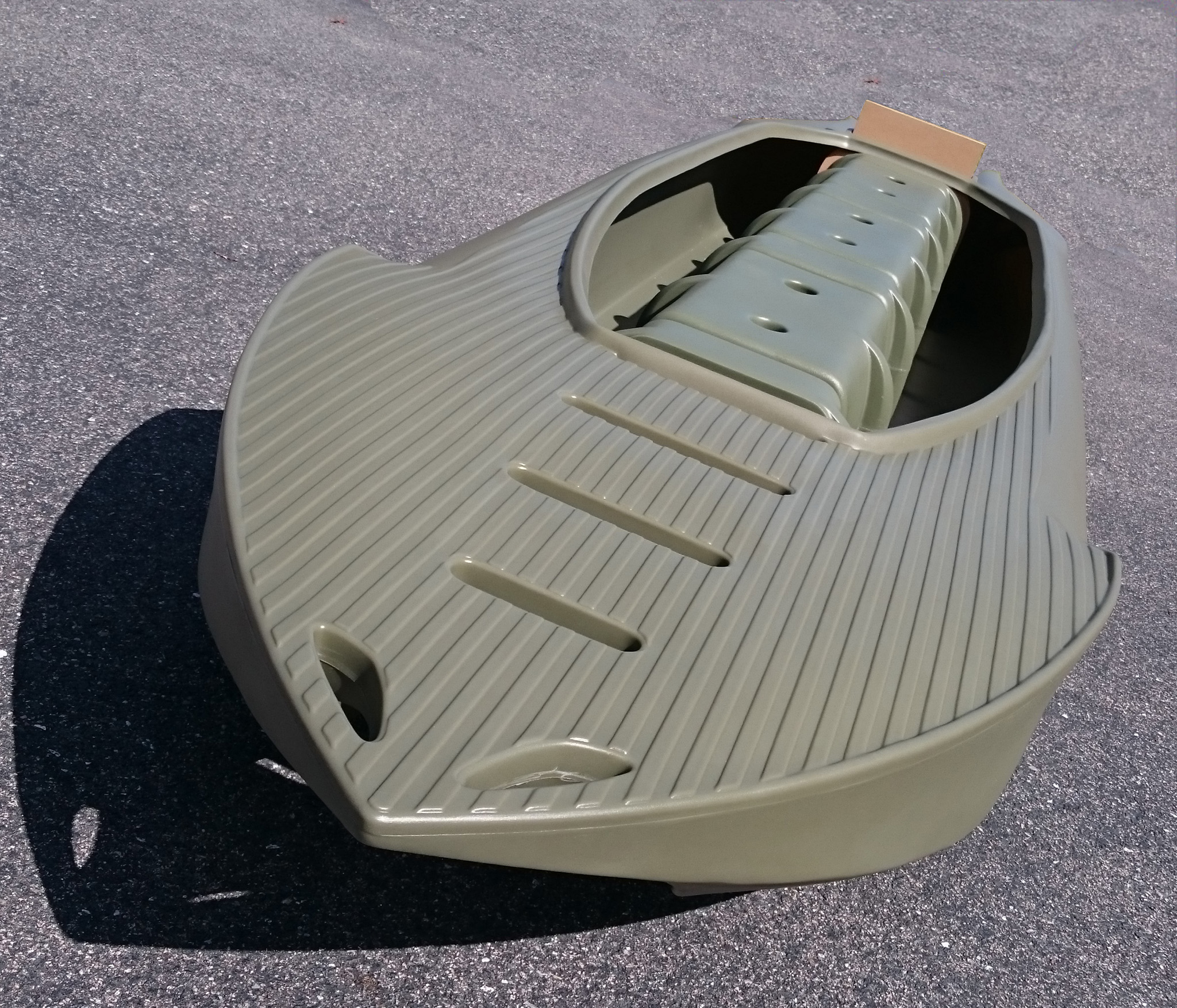
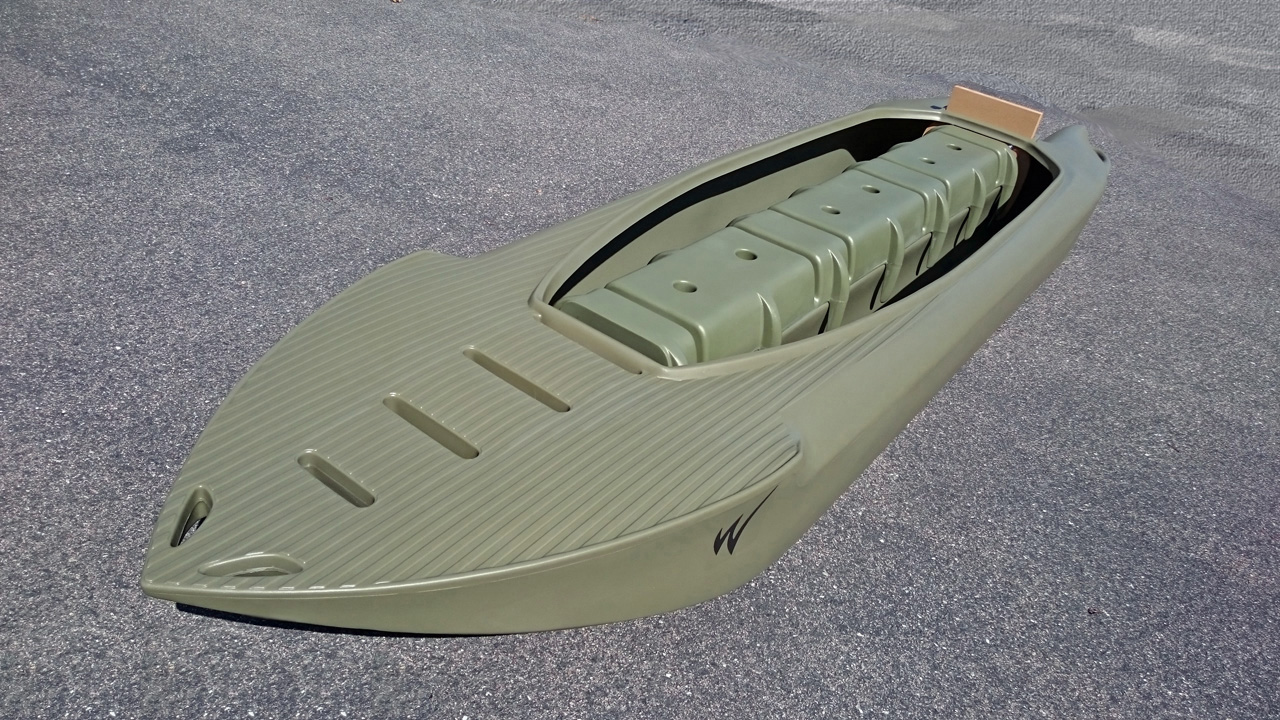
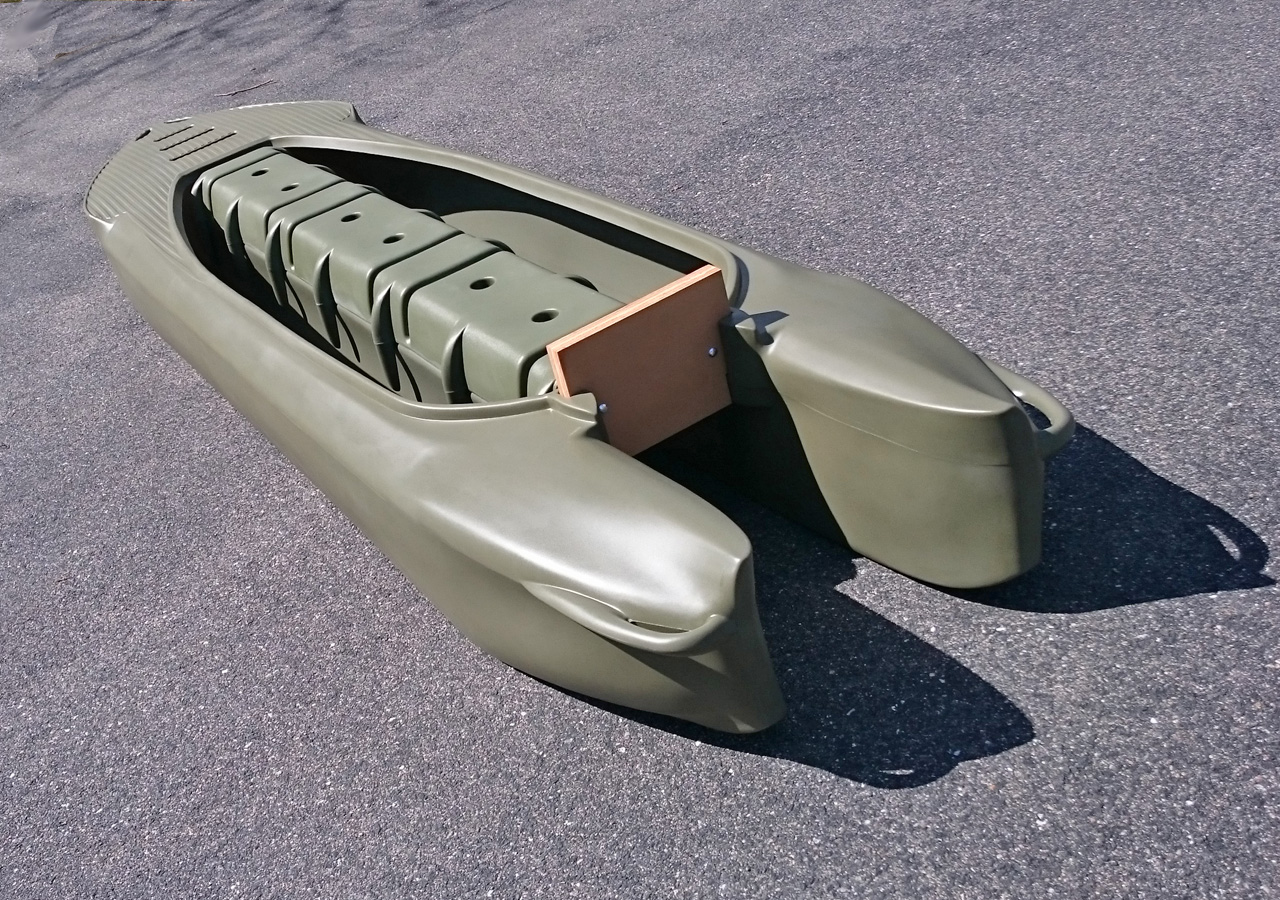
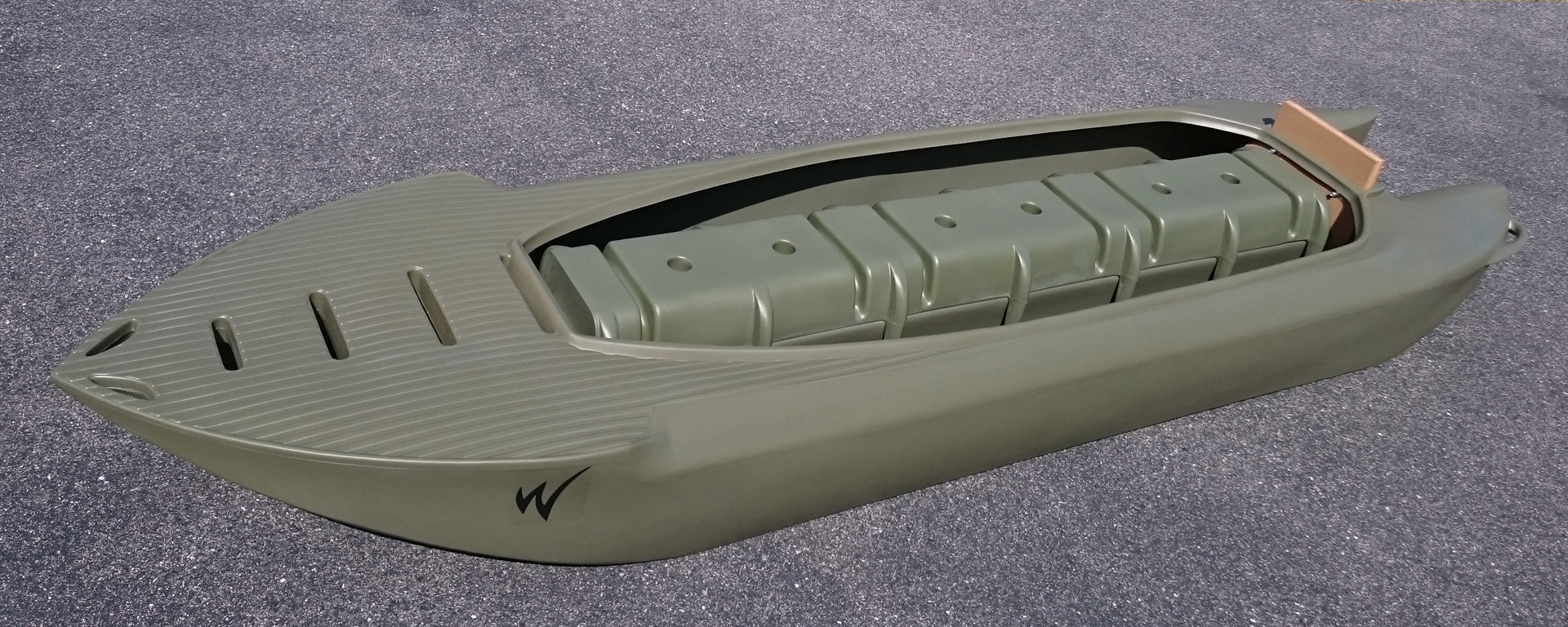
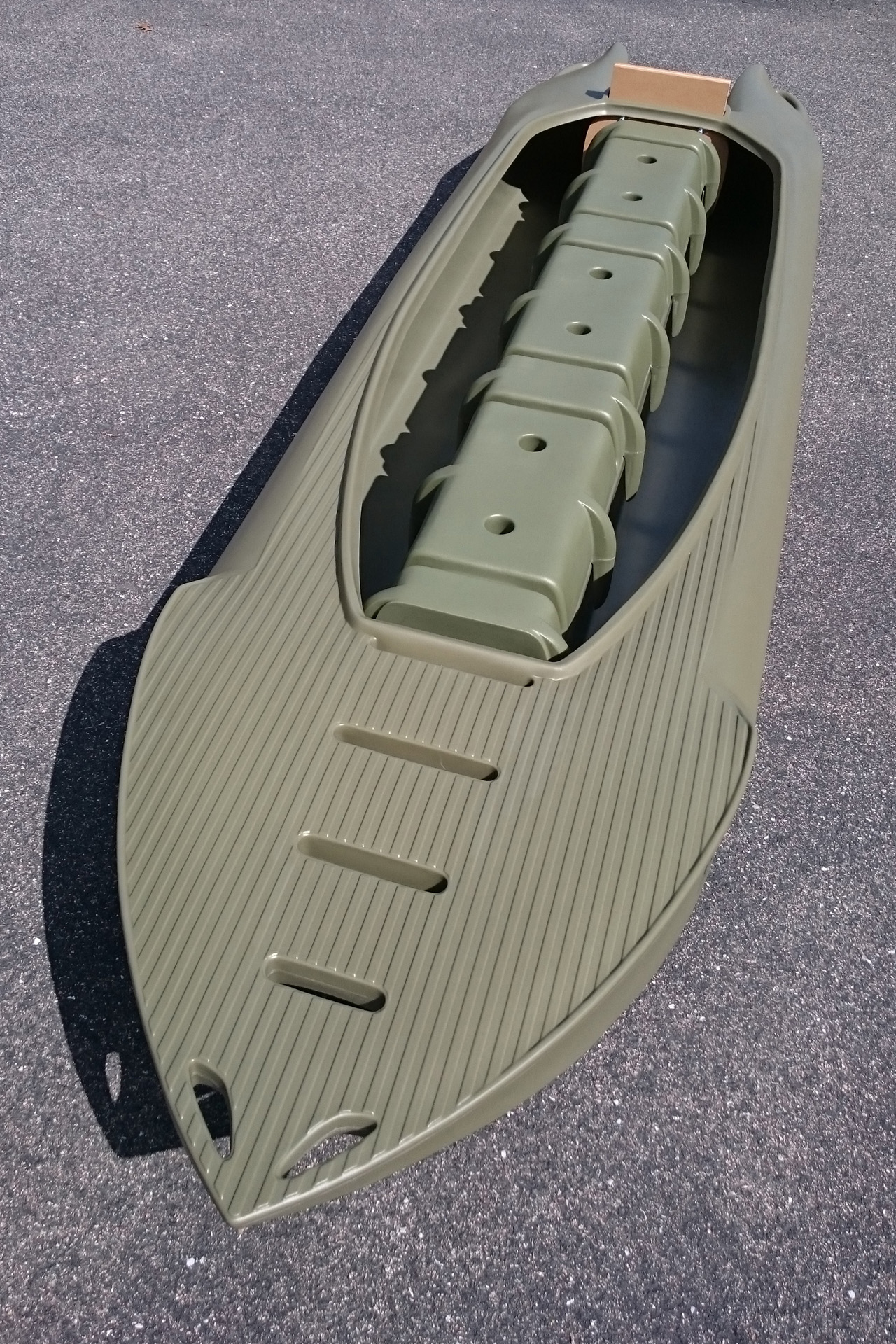
| Best Boat For Under $10,000 in 2024 |
Do you have any questions about this article?


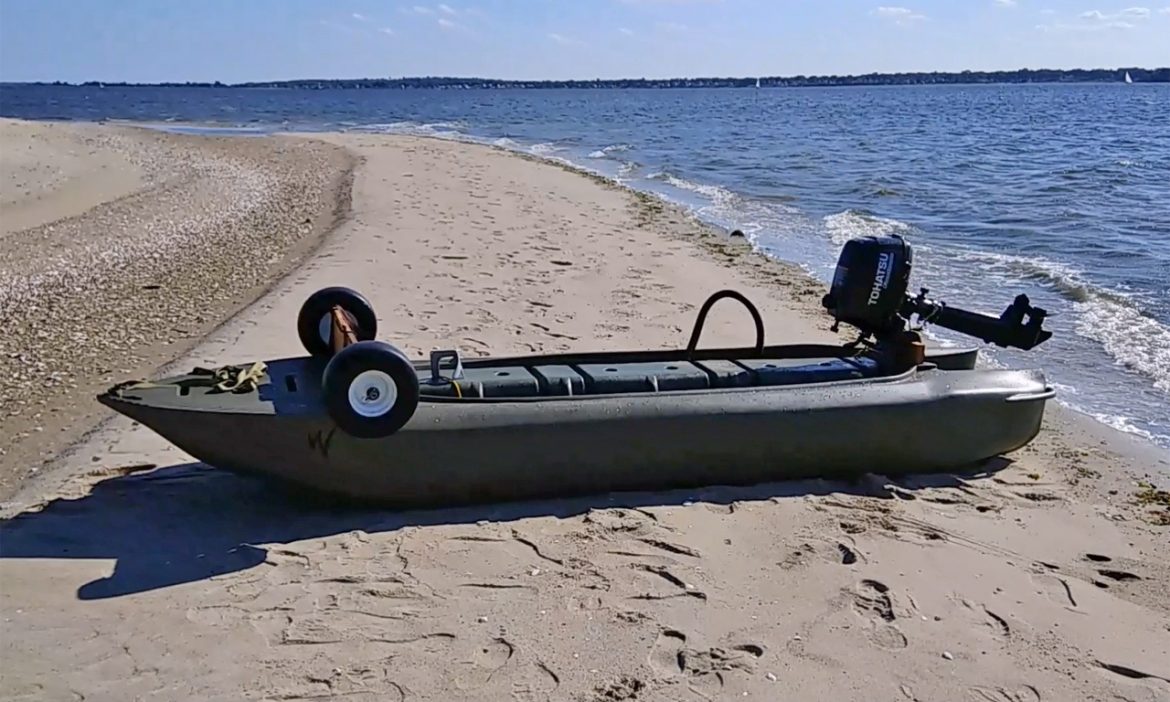
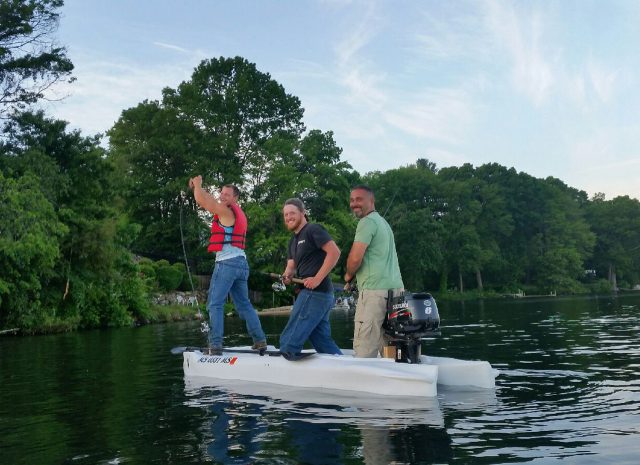
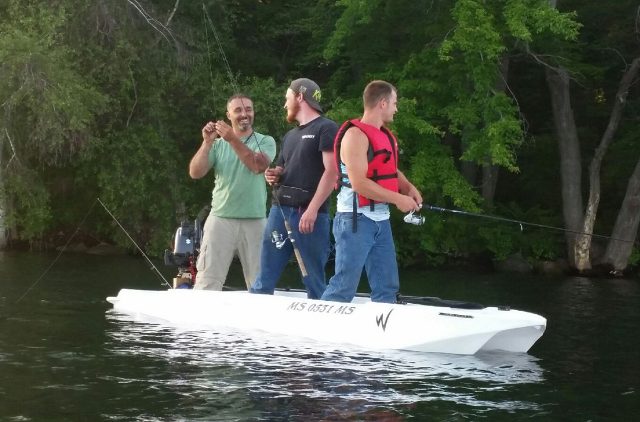
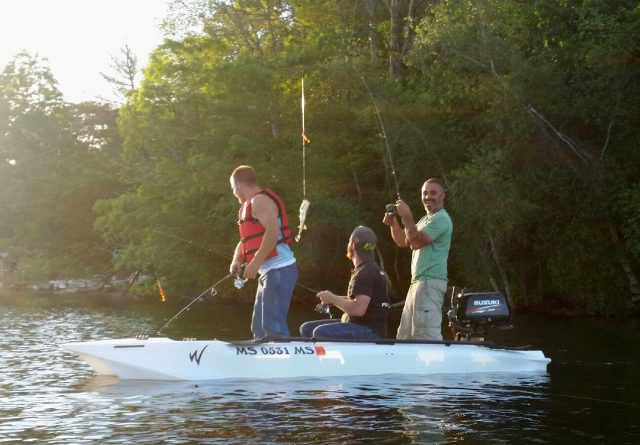
The notion of balancing capability as a very important factor in overall small boat stability is sometimes misunderstood by people who are used to think about stability in big boats, namely as a static number derived from the hull’s dimensions.
All of us have ridden a bicycle at some point in our life, and none of us would qualify a bicycle as a stable vehicle. And yet, people seldom fall of their bicycles, although this vehicle’s own stability is null. This is not due a miracle, but to the fact that bicycles offer humans excellent means to stabilize themselves – easily, intuitively, and most effectively.
The same is true for motorcycles and personal watercraft (PWC), which can be driven at high speeds and in difficult conditions.
Yoav,
Usually, Jonboats are made of aluminum. They are generally heavier and stiffer than the lightweight polyethylene Wavewalk S4 design. Also, the larger Jonboats can accommodate big motors and are stable enough to wrestle large alligators onto the deck.
For those of us who are not hunting gators or can not afford ten thousand dollar plus motor packages, the S4 is the perfect motor yak that comes in a stable, attractive, and affordable package.
Though I enjoyed using a Sears 12 semi-vee aluminum skiff for many years on near shore fishing trips, I have had far more fun with my new S4. I can easily transition from motorized status to paddling in the numerous non-combustion zones that have been implemented in my marine backyard.
And, I can add an electric trolling motor too.
The S4 coupled with an affordable motor in the 3.5 to 8 hp range will provide a level of aquatic accessibility unmatched by any Jonboat or skiff that I am familiar with.
So, if you are looking to transport a boatload of alligators, get that big aluminum swamp boat. But, for go anywhere fun and affordable fishing or watersports, the S4 is the better choice.
Larry J.
Here in New England, we don’t even have a choice between regular passengers and alligators 😀
Jon boats are a popular and broad class of boats, and a fascinating subject.
The main eternal debates seem to be “Jon boat vs. Skiff”, “Flat bottom vs. Semi-V hull”, and “Welded vs. Riveted”.
I must confess that I really like watching videos showing people driving Jon boats outfitted with mud motors 😮
Yoav
At one time, I considered mounting a mud motor on the W700. However, I am so satisfied with the performance of the lightweight 2 and 4 stroke outboards that this option is off the table, for awhile.
The “balancing stability” of the Wavewalk design is like having your own horse on the water without the daily feed, stall, vet, and other maintenance costs. And, the S4 can take up to three people at a gallop.
Happy Trails…
Larry J.
I don’t know what a mud motor is, but when I got to Florida, my first purchase was a 16 foot go-devil boat and motor which could stir up lots of mud and get into places normally restricted to airboats. It was a bear to steer, and after trailering it around for a few months and waiting in long lines at boat ramps, it didn’t take me long to get rid of it in favor of my first 300 Wavewalk, which turned out to be one of the best decisions I’ve made over the last 10 years. I wonder how many boat / skiff owners would do the same if they were aware of the diverse fishing and recreational boating opportunities available with the three W models.
Thanks Gary,
Being a rather impatient fellow, I’d go nuts if I had to wait at boat ramps.
A mud motor is a type of outboard gas motor designed especially for going in very shallow (a.k.a. ‘skinny’) water, weed infested water, grass, mud, and over obstacles.
Easy steering is not the forte of such motors, but they truly work in those difficult marshy and muddy areas, and I strongly recommend going to YouTube and watching videos of people doing incredible (and incredibly fun) things with these motors.
Not that some 20″ long shaft (L) outboard motors offer a tilted position for their propeller shaft, which improves the motor’s performance in very shallow water.
Yoav
Thanks, Yoav……….that sure sounds like my go-devil. During summer scallop season around here, ramp waits can be an hour or more, and if you don’t get there early, there’s no place to park. How great it is to park on the side of the road and just slide the W in.
Gary,
Waiting an hour to launch a boat at a boat ramp is something I can’t even imagine, let alone waiting another hour to take the boat out of the water…
The world must be an awful place for an angler who faces a choice between the torture of waiting at a boat ramp to launch their boat from its trailer (and back to it…), and all sorts of fishing kayaks that are wet, unstable, and would eventually make their users’ back hurt.
Wavewalk’s three product lines cover the entire range from a lightweight one man kayak to a full fledged, high performance, car-top motorboat.
Aah, if only I was a better marketer! 😮
Yoav
Gary and Yoav,
The S4 is the perfect motorized kayak with a 3.5-8 hp motor depending on your own personal lifting capability. And. it paddles very well.
The W700 is the most stable paddling tandem kayak available that can, also, easily be motorized for long distance hauls.
And, the W500 is a very stable and comfortable solo kayak that is super easy to convert to electric or low power outboard motor.
Each has it’s own niche according to the end user. But, all are better than conventional yaks from a portability, stability, and comfort point of view.
Until the mud motors lighten up, those long shaft Tohatsu built small outboards are the right means to bottle up and go.
Been there. Done that.
Larry J.
Larry,
Using definitions such as “kayak” and “motorized kayak” is helpful in some way, as it provides a category of reference to place the Wavewalk model in.
It’s also a correct definition from a legal standpoint 🙂
But these definitions are pretty limited, and in this sense using them can also limit the way the Wavewalk is perceived and understood.
The example that comes to my mind is the fact that in its capacity as a skiff, the S4 works more completely with a crew of the two than it does as a solo skiff. The reason for this is that a second (and preferably heavy) angler sitting at the rear end of the S4 cockpit, next to the motor, makes the stand up casting platform at the bow more level, and therefore more practical as such for the second member of the crew to fish from.
This example is refers to things that are outside the range defined by the term “motorized kayak”.
I’m pretty sure that as the S4 gets more mileage in the ocean and as a motorboat (“Jon boat”?, “skiff”?, “dinghy”? “runabout”? etc.) it will develop more of a “personality” and an “image” of a motorboat. These things take time, YouTube videos, and reviews.
People looking at the photo of you driving your S4 with two ladies on board are not likely to associate this image with kayaks or kayaking, or even with motorized kayaks*. Arguably, that picture shows 3 boaters having fun on board a nifty small motorboat 😀
Yoav
* In reality, “motorized kayak” is a term that describes mainly fishing kayaks outfitted with electric motors. Examples of sit-in and SOT kayaks that are successfully outfitted with outboard gas engines don’t abound, and a detailed scrutiny would reveal that such SIK and SOT setups are typically somewhere between dysfunctional and nonsensical.